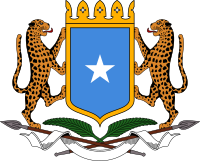
Back الحكومة الاتحادية الانتقالية الصومالية Arabic فدرال گئچیش حوکومتی AZB Govern Federal de Transició Catalan Übergangsregierung Somalias German Transira Federacia Registaro Esperanto Gobierno Federal de Transición (Somalia) Spanish دولت فدرال انتقالی سومالی Persian Somalian siirtymäkauden hallitus Finnish Gouvernement fédéral de transition French ממשלת המעבר הפדרלית של סומליה HE
Transitional Federal Government of the Republic of Somalia | |||||||||
|---|---|---|---|---|---|---|---|---|---|
| 2004–2012 | |||||||||
| Anthem: (2004–2012) "Soomaaliyeey toosoo"(2012) "Qolobaa Calankeed" | |||||||||
 | |||||||||
| Capital | Mogadishu | ||||||||
| Common languages | Somali · Arabic · | ||||||||
| Government | Federal provisional government | ||||||||
| President | |||||||||
• 2004-2008 | Abdullahi Yusuf Ahmed | ||||||||
• 2009-2012 | Sheikh Sharif Ahmed | ||||||||
| Prime Minister | |||||||||
• 2011-2012 | Omar Sharmarke | ||||||||
| Legislature | Transitional Federal Parliament | ||||||||
| Historical era | Somali Civil War | ||||||||
| 14 October 2004 | |||||||||
| 20 August 2012 | |||||||||
| ISO 3166 code | SO | ||||||||
| |||||||||
 |
|---|
|
|
|
|
The Transitional Federal Government (TFG) (Somali: Dowladda Federaalka Kumeelgaarka, Arabic: الحكومة الاتحادية الانتقالية) was internationally recognized as a provisional government of the Somalia from 14 October 2004 until 20 August 2012, when its tenure officially ended and the Federal Government of Somalia (FGS) was inaugurated.[1]
Succeeding the Transitional National Government (TNG) that had been formed in 2000, the TFG was the second interim administration aiming to restore national institutions to Somalia after the 1991 collapse of the Siad Barre regime and the ensuing Somali Civil War.[2] After being formed in Kenya during 2004, the TFG saw two presidents during its tenure: Abdullahi Yusuf Ahmed from 2004 and Sharif Sheikh Ahmed from 2009 until the transition to the FGS in 2012.
In 2005, the government relocated to Somalia from Kenya and made Baidoa its capital. During mid-2006 the Islamic Courts Union (ICU) rose to power after defeating an alliance of Somali warlords, becoming the first political entity to control Mogadishu since 1991. After several merger talks in Khartoum during the following months failed over the issues of foreign military forces in Somalia and ICU expansion out of the capital, US backed Ethiopian troops launched a full-scale invasion in late 2006 and installed the TFG under President Abdullahi Yusuf in Mogadishu. The invasion and foreign occupation sparked a large scale insurgency that led to the rise of Al-Shabaab, resulted in an Ethiopian military withdrawal and the resignation of President Yusuf two years later. As the insurgency escalated, a conference between rebel forces and the TFG was opened in Djibouti during 2008. Elements of the insurgency were merged into the TFG parliament in late 2008. Soon after Sharif Ahmed, former head of the ICU and leader of the Alliance for the Re-liberation of Somalia (ARS) was elected president at the start of 2009.
Four years later the TFG transitioned to the Federal Government of Somalia.
- ^ "Somalia: UN Envoy Says Inauguration of New Parliament in Somalia 'Historic Moment'". Forum on China-Africa Cooperation. 21 August 2012. Archived from the original on 27 March 2014. Retrieved 24 August 2012.
- ^ Central Intelligence Agency (2011). "Somalia". The World Factbook. Langley, Virginia: Central Intelligence Agency. Archived from the original on 1 July 2014. Retrieved 5 October 2011.

